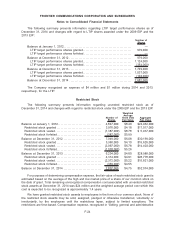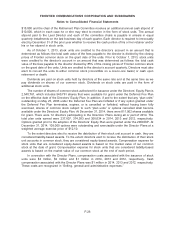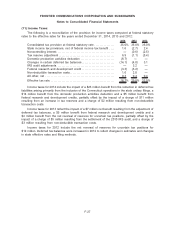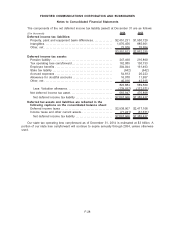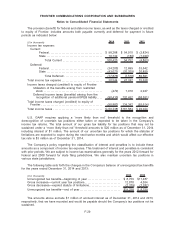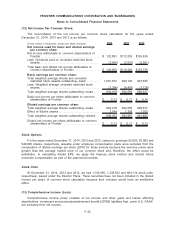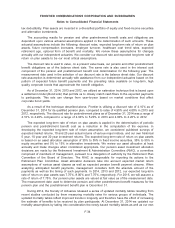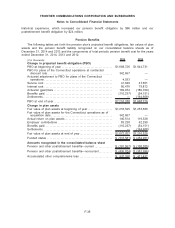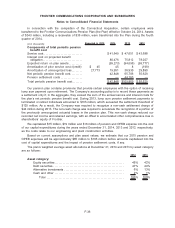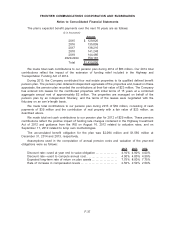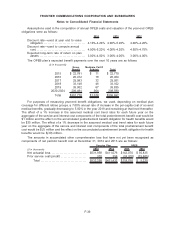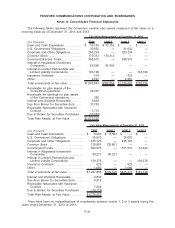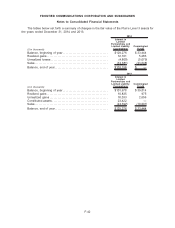Frontier Communications 2014 Annual Report Download - page 95
Download and view the complete annual report
Please find page 95 of the 2014 Frontier Communications annual report below. You can navigate through the pages in the report by either clicking on the pages listed below, or by using the keyword search tool below to find specific information within the annual report.tax deductibility. Plan assets are invested in a diversified portfolio of equity and fixed-income securities
and alternative investments.
The accounting results for pension and other postretirement benefit costs and obligations are
dependent upon various actuarial assumptions applied in the determination of such amounts. These
actuarial assumptions include the following: discount rates, expected long-term rate of return on plan
assets, future compensation increases, employee turnover, healthcare cost trend rates, expected
retirement age, optional form of benefit and mortality. We review these assumptions for changes
annually with our independent actuaries. We consider our discount rate and expected long-term rate of
return on plan assets to be our most critical assumptions.
The discount rate is used to value, on a present value basis, our pension and other postretirement
benefit obligations as of the balance sheet date. The same rate is also used in the interest cost
component of the pension and postretirement benefit cost determination for the following year. The
measurement date used in the selection of our discount rate is the balance sheet date. Our discount
rate assumption is determined annually with assistance from our independent actuaries based on the
pattern of expected future benefit payments and the prevailing rates available on long-term, high
quality corporate bonds that approximate the benefit obligation.
As of December 31, 2014, 2013 and 2012, we utilized an estimation technique that is based upon
a settlement model (Bond:Link) that permits us to closely match cash flows to the expected payments
to participants. This rate can change from year-to-year based on market conditions that affect
corporate bond yields.
As a result of the technique described above, Frontier is utilizing a discount rate of 4.10% as of
December 31, 2014 for its qualified pension plan, compared to rates of 4.90% and 4.00% in 2013 and
2012, respectively. The discount rate for postretirement plans as of December 31, 2014 was a range of
4.10% to 4.20% compared to a range of 4.90% to 5.20% in 2013 and 4.00% to 4.20% in 2012.
The expected long-term rate of return on plan assets is applied in the determination of periodic
pension and postretirement benefit cost as a reduction in the computation of the expense. In
developing the expected long-term rate of return assumption, we considered published surveys of
expected market returns, 10 and 20 year actual returns of various major indices, and our own historical
5 year, 10 year and 20 year investment returns. The expected long-term rate of return on plan assets
is based on an asset allocation assumption of 35% to 55% in fixed income securities, 35% to 55% in
equity securities and 5% to 15% in alternative investments. We review our asset allocation at least
annually and make changes when considered appropriate. Our pension asset investment allocation
decisions are made by the Retirement Investment & Administration Committee (RIAC), a committee
comprised of members of management, pursuant to a delegation of authority by the Retirement Plan
Committee of the Board of Directors. The RIAC is responsible for reporting its actions to the
Retirement Plan Committee. Asset allocation decisions take into account expected market return
assumptions of various asset classes as well as expected pension benefit payment streams. When
analyzing anticipated benefit payments, management considers both the absolute amount of the
payments as well as the timing of such payments. In 2014, 2013 and 2012, our expected long-term
rate of return on plan assets was 7.75%, 8.00% and 7.75%, respectively. For 2015, we will assume a
rate of return of 7.75%. Our pension plan assets are valued at fair value as of the measurement date.
The measurement date used to determine pension and other postretirement benefit measures for the
pension plan and the postretirement benefit plan is December 31.
During 2014, the Society of Actuaries released a series of updated mortality tables resulting from
recent studies conducted by them measuring mortality rates for various groups of individuals. The
updated mortality tables reflect improved trends in longevity and therefore have the effect of increasing
the estimate of benefits to be received by plan participants. At December 31, 2014 we updated our
mortality assumptions by taking into consideration the newly issued mortality tables as well as our own
F-34
FRONTIER COMMUNICATIONS CORPORATION AND SUBSIDIARIES
Notes to Consolidated Financial Statements


